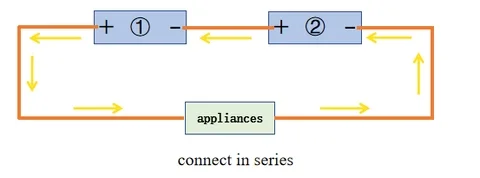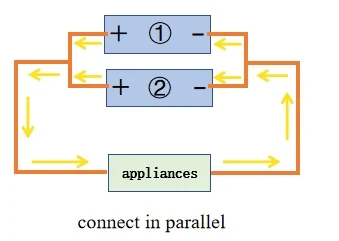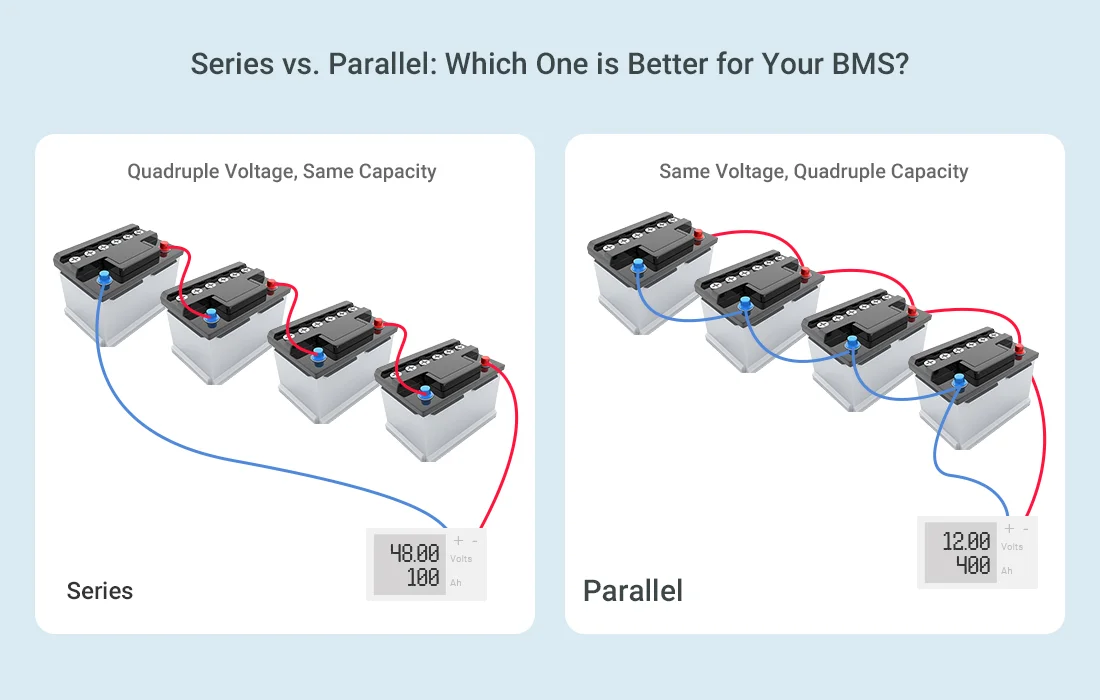When it comes to designing an efficient energy storage system, the configuration of batteries in series and parallel plays a crucial role. Both series and parallel battery connection methods have unique advantages and challenges that can significantly impact the performance of a battery management system (BMS). This article will explore the difference between series and parallel batteries, addressing common questions and considerations to help you make informed decisions for your energy storage projects.
What is the Series Connection of Batteries?
Battery series connection involves linking multiple batteries in a sequence to achieve higher voltage output. This setup requires connecting the positive terminal of one battery to the negative terminal of the next, and so on, until the desired voltage level is reached. Despite the increased voltage output, the overall capacity of the battery pack is still equivalent to the capacity of a single cell. Series connections are widely used in scenarios where voltage must be increased, such as backup power for electric vehicles, solar power systems and buildings.

Advantages of battery Series Connection for BMS
- Enhanced Voltage Output: Series connections are particularly advantageous for applications that demand higher voltage levels, making them a preferred choice for electric vehicles and solar power systems.
- Efficient Energy Storage: With a series-connected battery pack, each battery bears an equal share of the load, ensuring balanced charging and discharging, ultimately leading to more efficient energy storage.
Challenges of battery Series Connection for BMS
- Imbalance Risk: When batteries with varying capacities or ages are interconnected in a series, they may discharge at different rates, causing an imbalance in the pack’s voltage. This imbalance can cause some batteries to overcharge, posing a safety risk and potentially shortening the overall life of the battery pack.
- Unchanged Capacity: Series connection does not augment the overall capacity of the battery pack; rather, it only elevates the voltage output without affecting the capacity.
Real-World Applications of Batteries in Series
- Electric Vehicles (EVs): Series connections provide the necessary voltage levels for electric vehicle battery packs, enabling efficient electric motor operation and extending driving range.
- Solar Power Systems: Series connections enable higher voltage output for grid-tied solar power systems, enhancing overall energy efficiency.
What is the Parallel Connection of Batteries?
Battery parallel connection entails linking multiple batteries together by connecting their positive terminals and negative terminals, resulting in a collective increase in the overall capacity of the battery pack. In this arrangement, each battery shares the load evenly, leading to a higher current output and an overall boost in capacity. It is worth noting that the battery pack’s output voltage is consistent with the output voltage of the individual cell. Parallel connections are widely used in applications where high capacity is a prerequisite, such as backup power for buildings, off-grid solar systems, and electric vehicles.

Advantages of battery Parallel Connection for BMS
- Increased Capacity: By harnessing the power of parallel connection, the overall capacity of the battery pack is significantly elevated, rendering it highly suitable for scenarios that demand ample capacity.
- Reduced Risk of Overcharging: The inherent independent charging and discharging mechanism of a parallel-connected battery pack mitigates the risk of overcharging or undercharging any individual battery. This proactive measure ensures the safety and extended service life of the entire battery pack, making it the first choice for a variety of applications
Challenges of Batteries in Parallel for BMS
- Balancing and Equalization with BMS: Maintaining a balanced charge and discharge between parallel cells is essential to optimize performance and service life.
- Efficiency Concerns: Parallel connections may introduce inefficiencies due to increased current requirements.
Real-World Applications of Batteries in Parallel
- Backup Power Supplies: Parallel connections provide higher capacity for critical backup power systems, ensuring continuous power availability for mission-critical applications.
- Off-Grid Solar Power Systems: Parallel connections handle high-power demands for off-grid solar power systems, ensuring reliable operations and energy independence.
A Comparative Analysis of batteries in series and parallel for BMS
Below is a detailed analysis of the performance of batteries in series and parallel for BMS:
| Aspect | Series Connection | Parallel Connection |
| Voltage Output | Higher voltage due to cumulative battery voltages | Same voltage as individual batteries |
| Capacity | Same as individual batteries | Higher capacity due to cumulative batteries |
| Redundancy | No inherent redundancy Failure in one battery impacts the entire pack | Redundancy ensures continued operation even if one battery fails |
| Balancing Complexity | More complex cell balancing is required to prevent overcharging or over-discharging | Easier balancing due to similar voltage levels |
| Current Handling | May have lower current handling capabilities due to individual battery limitations | Higher current handling capabilities with a combined battery capacity |
| Efficiency | Potential efficiency losses due to higher voltage and current demands | More efficient operation with balanced parallel batteries |
| Space Efficiency | Space-efficient; higher voltage output without adding extra battery packs | May require more space due to multiple battery packs |
| Maintenance and Serviceability | Individual battery monitoring and management required | Easier maintenance and serviceability |
Factors to Consider When Choosing parallel and series connection of the battery
When deciding between battery parallel and series battery connection for your BMS, consider the following key factors:
Power and Energy Requirements
- Voltage and Capacity: Series connections offer higher voltage output for applications requiring high power, while parallel connections provide increased capacity for higher energy storage.
- Load Profiles: Series connections suit constant loads, while parallel connections are better for fluctuating loads.
Environmental Factors and Operating Conditions
- Temperature and Climate: Evaluate the impact of temperature and climate on battery performance.
- Humidity and Moisture: Consider the level of humidity and its effect on battery corrosion.
Design Flexibility and Scalability
- Future Expansion: Parallel connections offer more flexibility for future capacity expansion.
- Space Constraints: Consider the physical space available for battery installation.
Maintenance and Serviceability
- Balancing and Equalization: Monitor and balance batteries in parallel, and equalize voltage levels in series.
- Replacement and Repairs: Parallel connections allow individual battery replacement.
Total Cost of Ownership (TCO) and ROI Analysis
- Initial Investment: Compare upfront costs of batteries and BMS equipment.
- Operational Expenses: Assess long-term maintenance and replacement costs.
- Return on Investment (ROI): Analyze overall cost-effectiveness based on lifespan and projected savings.
Hybrid Configurations and Advanced BMS Techniques
Hybrid Configurations with BMS: Hybrid configurations combine series and parallel connections to meet specific energy storage requirements, optimizing voltage and capacity balancing.
Advanced BMS Techniques: Sophisticated BMS algorithms and smart management strategies optimize battery performance in both series and parallel configurations.
MOKOEnergy’s Expertise in BMS
As a leading provider of advanced BMS solutions, MOKOEnergy has extensive experience in designing, manufacturing, and implementing cutting-edge BMS technologies for a wide range of applications. Our team of experts is dedicated to ensuring your energy storage system achieves the highest performance, safety, and reliability. With a focus on innovation and quality, we offer BMS solutions to your specific requirements, whether your project requires series, parallel or hybrid battery configurations.
Conclusion
In summary, whether you choose a series or parallel battery for a BMS depends on a variety of factors, including your specific energy needs, system scalability, maintenance needs, and overall budget. Both configurations have unique advantages and challenges, and smart decisions can significantly impact the performance and lifetime of an energy storage system. Whether you choose a series, parallel, or hybrid configuration, a well-designed BMS is essential to ensure optimal battery pack performance, safety, and efficiency. Contact us for our BMS solutions and contribute to a more sustainable future together.
CONTINUE READING ABOUT BATTERIES IN SERIES AND PARALLEL






